---
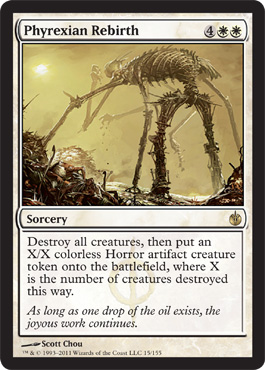
The immediate comparison would be to put this next to Kirtar's Wrath. The latter sweeps regenerators clean, but Phyrexian Rebirth's creature token is often much bigger, albeit without evasion. Which would be more valuable? In the end, it depends on your Stack. Many "modern" stacks have only a few regenerators, replacing creatures with that ability with the "new regeneration:" Indestructible. In such a case, you might as well get the larger token from the bargain.

Compare this to Windbrisk Raptor. The first difference you'll notice is that this creature grants all your creatures flying, whereas the Raptor does not. Is this important? On the surface, it seems like the answer is yes, until you realize that most T4 beaters already fly or have some other form of evasion. If your stack is lacking evasive beaters, then this creature's ability is a step up from the Raptor. If your stack is filled with evasive beaters, then the Raptor's superior 5/7 body increases its survivability and beatdown power. The lifelink is golden though, so if your stack has room for both, so much the better.

A bit to small to be a proper beater, this sphinx is more utilitarian in that he draws you cards. The potential reward is great. To exceed the value of Opportunity, it must survive for two of your opponent's turns (Two cards drawn each for two opponents plus someone spending a card to kill this = 5 cards). Any longer than that and this guy just became ridiculous.

Stealing one of your opponent's creatures is still a great form of removal. This of course must be compared to the standard Control Magic. For a comparison, just answer the question: Do you want a stolen beater to have Infect? Well... if it's hugely huge, with a power of 10 or greater, then the answer is universally yes. Remember, 10 poison counters is death. Any more is icing. Same goes for any evasive creatures that can kill in two swings, which is most of the decent beaters in a stack. Also, if the stolen creature is hard to kill or has immunities, it makes a great defender due to the -1/-1 counter buildup on enemy creatures.

Creepy art, check. "Counter target spell" hard counter text, check. Secondary effect, check. Need another hard counter to replace one of your vanilla Cancels or Counterspells? More than decent.
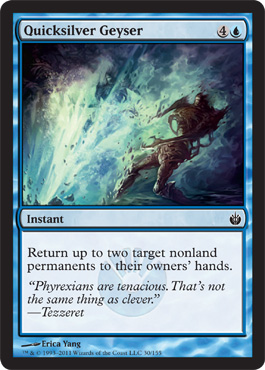
Bouncing two permanents, given the Rule of Law, can be crippling. Only downside is that there's a much better card out there that's much much harder to counter. If you don't have it, this is a decent tempo card for the stack (and kills those annoying Marit Lage tokens too).

This is one for the mass creature kill lists. It's a Flowstone Slide or Mutilate that kills even Crowd Favorites. The reshuffle effect goes great with cards like Aladdin's Lamp or Planar Portal.

It's small, has no evasion, and will kill barely anything. The secondary effect is similarly mediocre given that this won't kill anything save for a token-happy player who's sitting behind a swarm of 1/1's and 2/2's. It does combo well with Ixidron, but little else.
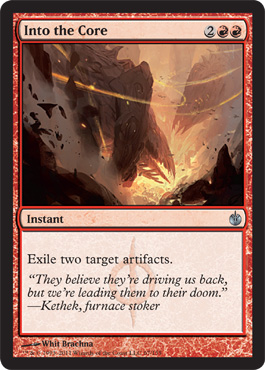
There are certain... artifacts of a very nasty nature that have a tendency to keep coming back, either by their own power or due to recursion combos. This would be an excellent way to make sure they never show up again, and you get a two-for-one.

Do you have this in your stack? Or this? Or even this? If so, don't bother with this strictly weaker version whose only redemptive value is being reshuffled. If you're missing those cards, then you might consider putting this in, provided you ave a decent number of green-colored beaters.

Wow. Just... wow. At last, a Yawgmoth's Will effect even better than the original card that T4 can use. Easily a top pick, and well worthy of the mythic rarity. Even better, its mana cost suggests it won't be very useful in Constructed, keeping the price of this gem low. Probably the best T4 card in the set.

Great abilities. The fact that he can't be countered is always excellent in T4. Trollshroud is the best kind of untargetability, and regeneration is always good for mixing it up with other creatures. He's SMALL. He's 2/2 below the T4 beater minimum. That's not so bad in itself until you combine it with his other drawback. He doesn't EVADE. He doesn't affect anything on the board but himself. So he's too small and non-evasive to be a beater, and has no utility save for blocking. Nail in the coffin. Save this for constructed formats.
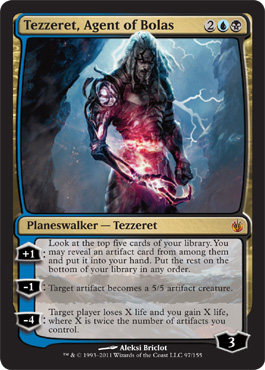
Let's go through the process of analyzing this planeswalker the way we did the others.
Question 1: Do his non-ultimate abilities do something that is playable in T4 at sorcery speed?
Question 2: Is his ultimate powerful enough to warrant using him anyway?
Answer 1: In an artifact-heavy stack, there might be enough artifacts going around to warrant his <+1> ability, but chances are, 5 cards is nowhere deep enough to dig. His <-1> ability changes one of your existing artifacts into a vulnerable 5/5 creature. Certainly not sterling. I suppose you could turn one of an opponent's artifacts into a creature then kill it with creature kill, but why would you spend a planeswalker on a two-card sometimes-useful combo?
Answer 2: Uhm. No. Ultimate is next to useless. Tezz should stick to Constructed, thankfully.

Remember what I said about artifacts of a certain nature that are hard to get rid of? This is a sterling example. He's not just tough. He's a beast. He kills in one hit. Legitimately. As in, without using or needing infinite mana. The last creature to be able to do this was Phage the Untouchable, and unlike her, this guy has no drawbacks. His presence legitimizes the existence of a few other "attack to kill" creatures in your stack. Imagine combining this guy with Miren, the Moaning Well and "Ach, Hans, Run!" Definitely a T4 staple and the second best T4 card in this set.
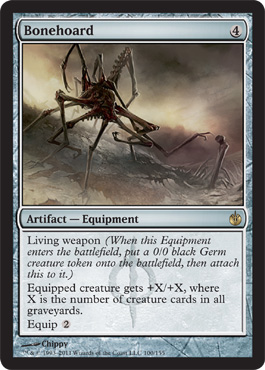
Is this better than Mortivore? It doesn't regenerate, but unlike Mortivore, it can stack onto your most evasive creature and can attack for massive damage. Imagine this on Skithiryx. Normally, when you judge equipment and creature enchantments for the stack, you'd have to determine if you really want the enhancements they provide, or would you just rather have a quality creature instead? By coming with its own built in creature, the Bonehoarder solves that problem for you.

Hmm... I look at this, and I realize it's technically a Shield of Kaldra reprint for T4. Then I take a glance at Spearbreaker Behemoth and Deathless Angel and realize that it's no longer necessary.

Right now, the only poisonous creatures worth T4 attention are the colossus and Skithiryx. Losing 2 life and milling six cards isn't worth using this to replace cards like Aladdin's Ring or Helm of Obedience.

This reminds me of Eye of the Storm in that it's making my head throb just trying to imagine the horrors of this in an 8 player table. I'd skip this, but if you're a fan of chaos multiplayer, then this is a must have.

Why would I use Meddling Kids and not this? Perhaps it's because the kids can shut down spells and entire strategies, including spells that can get rid of the kids. This guy? Not so much. He shuts down permanents, but that's it. And besides, if I wanted to shut down activated abilities, there's Azorius Guildmage.

The last card up for review is this baby, strictly better than Vindicate or Desert Twister. Being a solid artifact, it can be recursed more easily than sorceries which do the same thing. This plus Bosh. Think about it.
---
That's it for Mirrodin Besieged. Next, I work my way backard and review Scars of Mirrodin.


